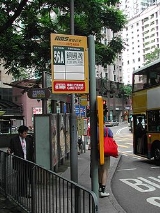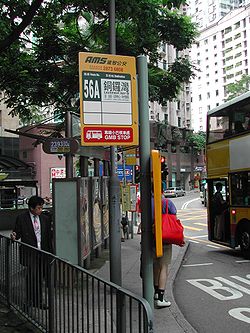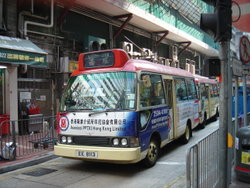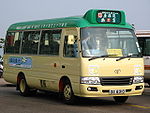
Public light bus
Encyclopedia

Public transport
Public transport is a shared passenger transportation service which is available for use by the general public, as distinct from modes such as taxicab, car pooling or hired buses which are not shared by strangers without private arrangement.Public transport modes include buses, trolleybuses, trams...
mode of transport
Mode of transport
Mode of transport is a term used to distinguish substantially different ways to perform transport. The most dominant modes of transport are aviation, land transport, which includes rail, road and off-road transport, and ship transport...
in Hong Kong
Hong Kong
Hong Kong is one of two Special Administrative Regions of the People's Republic of China , the other being Macau. A city-state situated on China's south coast and enclosed by the Pearl River Delta and South China Sea, it is renowned for its expansive skyline and deep natural harbour...
. It mainly serves the area that standard Hong Kong bus lines
Buses in Hong Kong
Bus services in Hong Kong have a long history. As of 2005, five companies operate franchised public bus services. There are also a variety of non-franchised public buses services, including feeder bus services to railway stations operated by MTR, and residents' services for residential estates...
cannot reach as efficiently. It is also colloquially known as a minibus or a van, defined as a kind of share taxi
Share taxi
A share taxi is a mode of transport that falls between taxis and conventional buses. These informal vehicles for hire are found throughout the world. They are smaller than buses, and usually take passengers on a fixed or semi-fixed route without timetables, usually leaving when all seats are filled...
.
Minibuses carry a maximum of 16 seated passengers; no standing passengers are allowed. Minibuses typically offer a faster and more efficient transportation solution due to their small size, limited carrying capacity, frequency and diverse range of routes, although they are generally slightly more expensive than standard buses. The popularity of public light bus services in Hong Kong is due to the high population densities which are needed to support the extensive network of minibus routes.
Overview
There are two types of public light minibus, Green minibuses and Red minibuses. Both types have a cream coloured body, the distinguishing feature being the colour of the external roof, and the type of service that the colour denotes. In the past, the minibuses had a band of red or green painted around the body instead of colouring the roof.Most of the minibus are Toyota Coaster
Toyota Coaster
The Toyota Coaster is a minibus produced by Toyota Motor Corporation. It was introduced in 1969, with the second generation introduced in 1982, followed by the third generation in 1993...
s, but a new and environmentally friendly Iveco
Iveco
Iveco, an acronym for Industrial Vehicle Corporation, originally an alliance of European commercial vehicle manufacturers such as Fiat , Unic and Magirus. Iveco is now an Italian truck, bus, and diesel engine manufacturer, based in Turin...
Daily Green minibus has also been introduced to reduce air pollution. Most of the buses run on Autogas
Autogas
Autogas is the common name for liquefied petroleum gas when it is used as a fuel in internal combustion engines in vehicles as well as in stationary applications such as generators. It is a mixture of propane and butane....
(liquefied petroleum gas or LPG). This type of fuel is not only cheaper, but also reduces emissions. The transport commission is making further efforts to reduce emissions by providing incentives for bus drivers to make the switch to even more efficient electric vehicles.
By 2005, there are 4,350 public light buses in Hong Kong, of which 1,660 are red minibuses (RMBs) and 2,690 are green minibuses (GMBs). The operations of these two types of services are regulated through conditions imposed by the Commissioner for Transport under the passenger service licences (PSLs).

History
The Public light bus service started as a result of the 1967 Hong Kong riotsHong Kong 1967 riots
The Hong Kong 1967 riots began in May 1967. They were caused by pro-communist leftists in Hong Kong, inspired by the Cultural Revolution in the People's Republic of China , who turned a labour dispute into large scale demonstrations against British colonial rule. Demonstrators clashed violently...
. Workers of China Motor Bus
China Motor Bus
China Motor Bus Company Ltd. , often abbreviated as CMB, was the first motor bus company in Hong Kong, and was responsible for the introduction of double-decker buses to Hong Kong Island....
and Kowloon Motor Bus
Kowloon Motor Bus
The Kowloon Motor Bus Company Limited , a company of the Transport International Holdings Limited, is the largest franchised bus operators in Hong Kong, and one of the largest privately owned public bus operators in the world...
were incited to go on strike
Strike action
Strike action, also called labour strike, on strike, greve , or simply strike, is a work stoppage caused by the mass refusal of employees to work. A strike usually takes place in response to employee grievances. Strikes became important during the industrial revolution, when mass labour became...
. During the riot, buses and tram
Tram
A tram is a passenger rail vehicle which runs on tracks along public urban streets and also sometimes on separate rights of way. It may also run between cities and/or towns , and/or partially grade separated even in the cities...
s were not available and the territory was ground to a halt.
The buses can also be traced back to a local minibus system (黑牌車) used in the New Territories
New Territories
New Territories is one of the three main regions of Hong Kong, alongside Hong Kong Island and the Kowloon Peninsula. It makes up 86.2% of Hong Kong's territory. Historically, it is the region described in The Convention for the Extension of Hong Kong Territory...
prior to 1960s. They were allowed to operate in the urban areas of Hong Kong after 1967 to ease commuter chaos.
At the time people with mini-vans provided transport to the public for a small charge. The government turned a blind eye even though it was against traffic laws to carry passengers without a passenger service licence. The 1969 legislation legalising the service making some 5,000 licences available for drivers caused some controversy. Some believed it was wrong of the government to issue licences to people who had been profiting from an illegal activity.
The first generation light buses were vans carrying nine passengers. The buses had a black and white checkered stripe and was colloquially referred to as the zebra car (斑馬車). This design later gave way to the red striped vans (colloquially as "red bus" or "14 seat") of today. Seating increased over the years to 14 and finally to 16 seats. Earlier minibuses featured a door on the front passenger side. The destination signage at the top front of minibuses did not appear until 1977 and the rear bench seat disappeared altogether following the installation of air conditioning.
Usage
A passenger wishing to get on a minibus simply hails the minibus from the street kerbHail and ride
Hail and Ride is a concept in public transport in the United Kingdom. Generally, it refers to boarding or alighting a mode of public transport by signalling the driver or conductor that one wishes to board/alight, rather than the more...
like a taxi. A minibus can generally be hailed down at any point along a route, subject to traffic regulations, although sometimes particular stops
Bus stop
A bus stop is a designated place where buses stop for passengers to board or leave a bus. These are normally positioned on the highway and are distinct from off-highway facilities such as bus stations. The construction of bus stops tends to reflect the level of usage...
are marked out. To alight from a minibus, a passenger customarily calls out to the driver where they wish to get off. The driver then raises his hand to acknowledge him. Tourists are often confused by the calling system, as one must know the route somewhat well to know when to call. Passengers often call out landmarks, intersecting streets and other distinctive features (such as immediately before or after a no-stopping zone
Clearway
The term clearway is used in several commonwealth countries to refer to stretches of road or street where parking is limited or prohibited.-Australia:...
). Some Green minibuses are now equipped with a bell operated similarly to those found on the larger buses, and ringing it indicates that a passenger requests the next stop. However, calling out to the driver is still the dominant method of letting the driver know that a passenger wishes to get off the minibus.
Green minibuses
Green minibuses operate a scheduled service, with fixed routes and fixed fares. There are currently around 250 green public light buses routes with route numbers assigned. The exact fare must be tendered, or payment can be made by Octopus cardOctopus card
The Octopus card is a rechargeable contactless stored value smart card used to transfer electronic payments in online or offline systems in Hong Kong...
. On some routes, passengers may pay a portion of the full fare (called section fare) if they are only travelling a section of the route. Sections are usually distinctive physical landmarks, such as crossing a tunnel
Tunnel
A tunnel is an underground passageway, completely enclosed except for openings for egress, commonly at each end.A tunnel may be for foot or vehicular road traffic, for rail traffic, or for a canal. Some tunnels are aqueducts to supply water for consumption or for hydroelectric stations or are sewers...
or a bridge
Bridge
A bridge is a structure built to span physical obstacles such as a body of water, valley, or road, for the purpose of providing passage over the obstacle...
.
Red minibuses
Red minibuses run a non-scheduled service, although many routes may in effect become fixed over time. Red minibuses may operate anywhere where no special prohibitions apply, without control over routes or fares. The operation of red minibuses provides services according to market demand.On some routes red minibuses may run through the whole day (24-hour service), such as Tai Po
Tai Po
Tai Po is an area in the New Territories of Hong Kong. It refers to the vicinity of the traditional market towns in the area presently known as Tai Po Old Market or Tai Po Kau Hui and the Tai Wo Town on the other side of the Lam Tsuen River, near the old Tai Po Market Station of the...
-Mong Kok, Tsuen Wan
Tsuen Wan
Tsuen Wan is a bay in the Kowloon area of Hong Kong, opposite to Tsing Yi Island across Rambler Channel. The market town of Tsuen Wan emerged for the surrounding villages and fleets of fishing boats in the area. The town is around the present-day Tsuen Wan Station of the MTR...
-Kwun Tong
Kwun Tong
Kwun Tong is an area in Kwun Tong District, situated at the eastern part of the Kowloon Peninsula, and its boundary stretches from Lion Rock in the north to Lei Yue Mun in the south, and from the winding paths of Kowloon Peak in the east to the north coast of the former Kai Tak Airport runway in...
, Kwun Tong-Mong Kok
Mong Kok
Mong Kok , less often known as Argyle , is an area in the Yau Tsim Mong District on Kowloon Peninsula, Hong Kong...
, Yuen Long
Yuen Long
Yuen Long , formerly Un Long, is an area and town located in the northwest of Hong Kong, on the Yuen Long Plain. To its west lie Hung Shui Kiu and Ha Tsuen, to the south Shap Pat Heung and Tai Tong, to the east Au Tau and Kam Tin, and to the north Nam Sang Wai.-Name:The Cantonese name Yuen Long 元朗...
-Jordan Road etc. Other routes may only run as midnight services, such as from Yuen Long-Causeway Bay
Causeway Bay
Causeway Bay is a heavily built-up area of Hong Kong, People's Republic of China, located on the Hong Kong Island, and covering parts of Wan Chai and Eastern districts. The Chinese name is also romanized as Tung Lo Wan as in Tung Lo Wan Road...
.
In most red minibuses, passengers pay just before they alight, and change for cash payment may be available, or may have a small amount deducted off the amount of change for the inconvenience (of giving change). Only a few red minibuses are equipped to accept payment by Octopus card. Red minibuses' fares and timetables are not regulated by the Government, and so, may occasionally be more expensive than their Green counterparts.
When travelling on a red minibus, the destination shown on the destination box may be an historical name of a place or a building which no longer exists "大丸" (Previous Japanese-owned department stores "Daimaru"). In the New Territories, they usually display Sheung Shui
Sheung Shui
Sheung Shui is an area in New Territories, Hong Kong. Sheung Shui Town, a part of this area, is part of the Fanling-Sheung Shui New Town in the North District of Hong Kong. Fanling Town is to its southeast.-History:...
, Castle Peak Road (and other busy roads), or Tai Po
Tai Po
Tai Po is an area in the New Territories of Hong Kong. It refers to the vicinity of the traditional market towns in the area presently known as Tai Po Old Market or Tai Po Kau Hui and the Tai Wo Town on the other side of the Lam Tsuen River, near the old Tai Po Market Station of the...
, etc., and sometimes carry a number. This number is a legacy of the pre-1973 route numbering in the New Territories. In those days red minibuses would carry a number indicating that it would travel on essentially the same route as bigger buses with that route number.
Fleet

United Kingdom
The United Kingdom of Great Britain and Northern IrelandIn the United Kingdom and Dependencies, other languages have been officially recognised as legitimate autochthonous languages under the European Charter for Regional or Minority Languages...
vehicles, but Japan
Japan
Japan is an island nation in East Asia. Located in the Pacific Ocean, it lies to the east of the Sea of Japan, China, North Korea, South Korea and Russia, stretching from the Sea of Okhotsk in the north to the East China Sea and Taiwan in the south...
ese minibuses appeared in 1969 and finally dominated the fleet by the 1980s.
- J TypeMorris Commercial J2The Morris Commercial J2 was a small, forward-control van launched by the Morris Commercial subsidiary of the British Motor Corporation in 1956 and produced until 1967...
12 seater - 1960s - Bedford CABedford CAThe Bedford CA was a distinctive pug-nosed light commercial vehicle produced between 1952 and 1969 by Vauxhall Motors subsidiary Bedford Vehicles, in Luton, United Kingdom....
- 1960s - Ford Transit Mk I (1965-1978)Ford TransitThe Ford Transit is a range of panel vans, minibuses, and pickup trucks, produced by the Ford Motor Company in Europe.The Transit has been the best-selling light commercial vehicle in Europe for 40 years, and in some countries the term "Transit" has passed into common usage as a generic term...
9 and 12 seaters - 1970's - Toyota CoasterToyota CoasterThe Toyota Coaster is a minibus produced by Toyota Motor Corporation. It was introduced in 1969, with the second generation introduced in 1982, followed by the third generation in 1993...
(both LPG and diesel) - Iveco DailyIveco DailyThe Iveco Daily is a large van produced by Iveco from 1978; it was sold also as Fiat Daily until 1983. It is also available as a minibus.-First generation :...
(all retired) - Mercedes-Benz SprinterMercedes-Benz SprinterThe Mercedes-Benz Sprinter is a light and heavy commercial vehicle, built by Daimler AG of Stuttgart, Germany as a van, chassis cab and minibus, and sold as a Mercedes model, except in the U.S. where it is built from complete knock down kits and was sold by Freightliner until 2010 when Mercedes...
311 (all retired) - Mitsubishi Fuso RosaMitsubishi Fuso RosaThe Mitsubishi Fuso Rosa is a minibus built by Mitsubishi Fuso.In Japan, Asia-Pacific, Mid-East, Africa, and South America, its principal competitors are the Isuzu Journey, Nissan Civilian, and Toyota Coaster.-Body types:...
(Only Green Minibus) - Nissan CivilianNissan CivilianThe Nissan Civilian is a minibus built by Nissan & UD. It is primarily available as city bus and tourist bus.In Japan, Asia-Pacific, Mid-East, Africa, South America, its principal competitors are Mitsubishi Fuso Rosa, Isuzu Journey and Toyota Coaster.-General information:Nissan Civilian is sold...
(all retired) - Nissan Echo (all retired)
Possible New Fleet
Some Green Minibus Unions have called for the Government to provide a new fleet of buses which can hold up to 20 people, 4 more people than the current 16 people. They say it could help ease traffic congestion during rush hour and possible push up profits which may turn away possible fare increases. There are a few of the new buses in service at the moment, but because it is only legal to have 16 passengers in a minibus, the extra area is used as a luggage rack. The Government has responded saying that minibuses are a secondary form of transport, therefore a expansion would not be required.Pros and cons of public light buses
Red minibusesAs routes are not tightly regulated, the flexibility of routes is higher than green minibuses, since drivers may choose the optimum route to travel.
The greatest problem are with fares. As the minibuses do not have fixed fares, routes and timetables, the fluctuations in fares can be quite large. Some routes may reduce their fares to an unreasonable price in order to win more passengers, but when demand increases (e.g. during typhoons
Tropical cyclone
A tropical cyclone is a storm system characterized by a large low-pressure center and numerous thunderstorms that produce strong winds and heavy rain. Tropical cyclones strengthen when water evaporated from the ocean is released as the saturated air rises, resulting in condensation of water vapor...
, when regulated buses and minibuses services are suspended), they can make increases in fares without limitation. For example, the route from Aberdeen to Wah Fu Estate could increase from $3 to $30 (probably equivalent to the fare travelled on a taxi), and the route from Jordan Road to Yuen Long could increase to $80, such acts have resulted in complaints from passengers.
Another issue is speeding. From late at night to the early morning, in order to make more rounds during their shifts to earn more, drivers may risk speeding. A typically long journey can be dramatically reduced. The government is trying to counter this by installing large, passenger-visible speedometers inside some minivans. This may be effective in some areas, however on the most part, most passengers do not seem to care if not even prefer the light buses to speed.
Cultural references
In the film Lost In TimeLost in Time (film)
Lost in Time is a 2003 Hong Kong drama film directed by Derek Yee and starring Cecilia Cheung, Lau Ching-Wan and Louis Koo.- Plot :Siu Wai is a young woman, whose fiancé has been killed in an accident. She takes on her late fiancé's minibus business in order to support his young son, Lok Lok...
, Cecilia Cheung
Cecilia Cheung
Cecilia Cheung Pak-Chi is a Hong Kong actress and cantopop singer. She is the ex-wife of Nicholas Tse, thus being the daughter-in-law of Patrick Tse and Deborah Lee. She and Nicholas have two sons, Lucas and Quintus Tse...
playing the role as a red minibus driver, won the "Best Actress" Awards in the 2004 Hong Kong Film Awards
23rd Hong Kong Film Awards
Ceremony for the 23rd Hong Kong Film Awards was held on 4 April 2004 in the Hong Kong Cultural Centre. Hosts for the ceremony consisted of Dayo Wong and a line-up of nine female celebrities, namely Bowie Tsang, Athena Chu, Candice Yu, Cherrie Ying, Terri Kwan, Ada Choi, Josie Ho, Kristy Yang and Jo...
.

